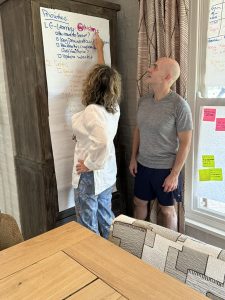
My Dimensions of Diversity (Natalie Spiro)
I am a woman with unique dimensions of diversity. Each aspect of my life contributes to a rich tapestry of experiences and perspectives. I
We’re driven by shared beliefs that allow us to work with all types of organizations across a wide range of industries to produce remarkable results.
A close-knit team with highly diverse backgrounds and skill sets, coming together with a singular purpose to deliver powerfully on your objectives and exceed your expectations.
To engage and retain talent in a rapidly evolving world, we must remain flexible and innovative in our approach to building and sustaining company culture.
Bringing in a professional coach is a smart path forward to unlock the potential observed in your leaders. Our certified coaches bring years of experience and can provide support and guidance. Empower and take your leaders to the next level.
We’re driven by shared beliefs that allow us to work with all types of organizations across a wide range of industries to produce remarkable results.
A close-knit team with highly diverse backgrounds and skill sets, coming together with a singular purpose to deliver powerfully on your objectives and exceed your expectations.
To engage and retain talent in a rapidly evolving world, we must remain flexible and innovative in our approach to building and sustaining company culture.
Bringing in a professional coach is a smart path forward to unlock the potential observed in your leaders. Our certified coaches bring years of experience and can provide support and guidance. Empower and take your leaders to the next level.

Part II in a series. Read part I, The Foundation for a Fresh Start in 2021.
Culture assessment: taking an in-depth look at how individuals, teams, and leaders view behavioral norms and identify talent strengths and weaknesses, along with employee expectations, engagement, and communication through surveys, focus groups, and interviews.
It’s a new year. To get off to a strong start, your organization has done a culture assessment or an engagement survey. Now what?
The next step in your journey is to create a more engaged, inclusive culture is to share what you’ve found out. Remind employees that leadership has recognized specific issues and is committed to addressing them. Perhaps it was high turnover, diversity and inclusion issues, cultural insensitivity, or low employee engagement. Having done the culture assessment, management can say we saw this issue, we asked for your input, and we heard what you said. Perhaps we’ve already started making improvements, but let’s talk about what we uncovered.
Honesty & accountability
What is the most effective way to share this feedback? While the impulse to be guarded in disclosing findings is understandable, transparent, and authentic communication is critical. The days of top-down, authoritarian messaging from remote executives are gone. Employees want and expect to hear an honest assessment, share their perspectives, and understand how they can be a part of the solution.
As communications plans are created and readied for execution, leaders must establish expectations and accountability for communicating honestly and transparently to the executive team, as well as team leaders. Leaders and managers should be prepared with talking points so they are comfortable discussing the next steps and answering questions about the culture assessment report and resulting plans. As leaders, they should be ready to balance open communications and strong direction for moving forward. Everyone should remember many employees will be hearing what their peers had to say in the surveys and focus groups for the first time.
Presenting your findings to the executive team and key project stakeholders is a good place to start. Explaining the results, subsequent analysis, and recommendations can help create buy-in and ensure alignment with these critical partners.
Channeling
There are several ways the findings and next steps can be introduced. A town hall is a great way to begin the communications process by explaining the findings and next steps, as well as answering questions and concerns. If the work has started, a few key stakeholders can share stories about the projects they are working on and the results they are seeing. After the town hall, a quick pulse survey can capture how the messaging was or was not received, identifying opportunities for additional communications, team meetings, and even small group discussions. Senior leaders should instruct managers to ask their teams for feedback on what was presented and share back what they heard. Setting specific expectations for gathering feedback shows accountability is a priority and transparent communications are a must.
Managers should continue to check in with teams as the work continues. They may ask, Are the communications you’re receiving make sense? Is everyone clear on what’s coming next? What questions do you have for me? However, simply increasing the frequency of communication is not an end in itself. Employees should know their perspectives are being heard, and that steps are being taken to address challenges, obstacles, and concerns.
Setting specific expectations for gathering feedback shows accountability is a priority
Existing communication channels are the logical place for ongoing culture work updates. A brief survey can help leaders determine the employees of the vehicle prefer or would like to see created. Any new channels should encourage cross-functional collaboration and communication.
Here are some vehicles and approaches for sharing news about culture work – some of which you are may already be using, and others to consider adding:
Managers are key to these efforts. Providing them with talking points to share with their teams before big announcements reinforces their role as communicators and invite input. As the organization places more emphasis on communications, some managers may benefit from coaching and development work to strengthen these skills and ensure the right messages are being communicated.
You’re building a team that’s not only ready but proud and enthusiastic to take on the work ahead
As the plan to advance the culture work comes together, another way to highlight its significance is to name it, brand it, and give employees a small token of appreciation. Maybe it’s a coffee cup, a t-shirt, or a water bottle with the initiative’s name and a graphic that captures its spirit and vision. You’re building a team that’s not only ready but proud and enthusiastic to take on the work ahead.
What’s to be gained?
Educating employees, addressing their concerns, and hearing their ideas all help create excitement for what’s to come. Robust and consistent two-way communication reinforces a culture that emphasizes listening, respect, giving and receiving feedback, motivation, and inclusion.
The ubiquity of social media has reinforced the idea that everyone deserves to be heard. No one now believes the only important voices sit in corner offices. Encouraging dialogue helps create stronger relationships and increased collaboration. Everyone, from the receptionist to the CEO, can be an effective brand ambassador if they believe in the organization. Using internal communications to define a positive, inclusive culture can help make that happen.
Everyone, from the receptionist to the CEO, can be an effective brand ambassador if they believe in the organization.
Organizations also see helpful impacts on turnover and recruiting from culture and communications efforts. Informed and engaged employees become true talent ambassadors who will promote the organization as a great place to work with friends, colleagues, and potential employees. Their excitement will be a catalyst for recruiting.
What’s next?
There are many ways to work toward strengthening communications. Human Resources frequently “owns” the internal communications function, and they play a substantial role in encouraging efforts around culture work, but it’s not them alone. Every member of the organization should understand the way forward and the part they play. If colleagues are struggling to support an initiative, it may require a deeper conversation, understanding their concerns, and probing to get to the root of the situation.
…the strategy is simple — to improve your culture, commit to honest, transparent, and consistent communication.
Leaders should be reminded that communications to all levels of their organizations should be a priority, reminding managers of their role, and holding them accountable for sharing information. Breaking down long-term initiatives into smaller projects with clear goals can help employees better understand how their efforts contribute to the outcome. A graph or chart on the intranet home page might show progress toward a specific metric, and everyone can see the impact their work is having. With the right tools and support, managers can build anticipation and enthusiasm among their teams.
You have many other ideas where to begin, but the strategy is simple – to improve your culture, commit to honest, transparent, and consistent communication. Share what has been uncovered, explain action plans and immediate goals, use existing channels, consider launching new ones, and help managers talk to and hear from their teams. Pick a place and make a start.
If employees can see the map, understand how to navigate it, and feel like valued members of the expedition, the journey can take you to amazing places.

I am a woman with unique dimensions of diversity. Each aspect of my life contributes to a rich tapestry of experiences and perspectives. I

Over the past year, in a coaching engagement, a client wanted to engage in inspiring and participating with their team to work together with more

In my professional life I was not lucky to have a mentor. I had people that supported me, gave me advice, and coached me, but